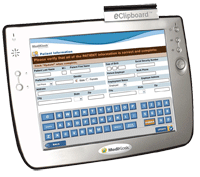Touch-screen kiosks improve the quality of care in medical institutions.

While technologies are constantly evolving and penetrating into the applied areas of production and services, the registration process in healthcare institutions has remained almost unchanged for 30 years. Each patient is obliged to defend a queue to the registrar in order to receive a referral or another required prescription or document. As a result of this organization of work, the patient is forced to spend a long time in the queue, and in the work of the registrar there appears the likelihood of errors, which ultimately results in a general negative attitude towards the health sector. Galvanon tried to solve this problem using the MediKiosk touch-screen kiosk.
Galvanon (a subsidiary of NCR Corporation), which is engaged in the development of self-service technologies in the field of health care, set about automating the process of registering patients and reducing the time required to process documents. The company has developed and introduced a special touch kiosk "MediKiosk".
Approximately 50% of patients already use installed touch terminals. Patients can activate their personal data in the terminal database using a driver's license and a plastic card. As soon as the patient’s identity is confirmed, the touch-screen kiosk program offers to perform various actions: check insurance information, review the doctor’s appointment schedule, fill out registration forms. If the patient does not have an identity card, the kiosk takes a photo and stores it in a database for future authorization of the patient by photo.
The software used in the MediKiosk touch-screen kiosk is highly customizable and can reflect real-time patient information and patient history. Software updates occur automatically by remote administration.
')
Already today, many patients and clients of the clinics appreciated all the advantages of the MediKiosk touch-screen kiosk. Mike Webster, vice president of self-service solutions at NCR, reports that the successful use of self-service systems in other industries paved the way for health care, and now using these technologies can significantly reduce the waiting time and patients in hospitals. The MediKiosk touch-screen kiosk in the clinic is able to fully automate the queue, the registration procedure, eliminate the need for manual input, and generally improve the speed and quality of service.
According to the National Center for Health Statistics, Americans made over 1.1 billion visits to doctors and other medical facilities in 2004.
Source: https://habr.com/ru/post/10518/
All Articles